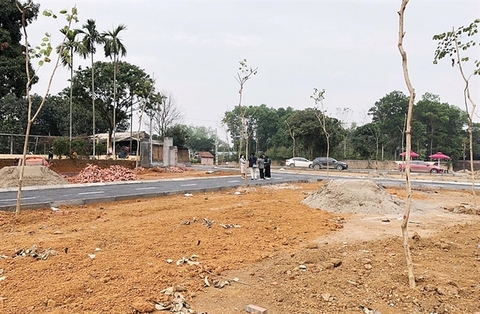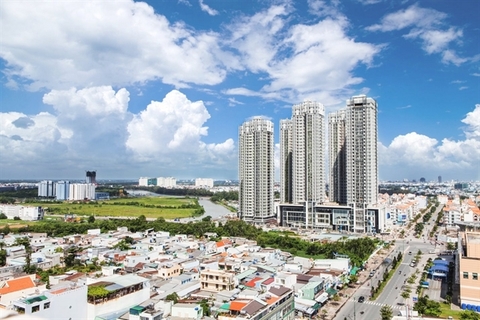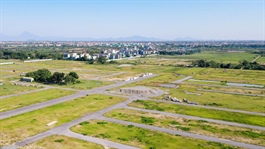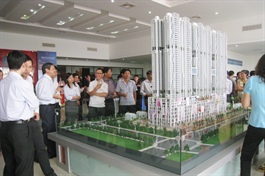High-rise space management needs to go hand-in-hand with sustainable development
High-rise space management needs to go hand-in-hand with sustainable development
To clarify the shortcomings in the development of high-rise buildings and understand proposals for sustainable and effective exploitation of high-rise space sin the urban area, Construction (Xay dung) online newspaper spoke to Nguyen Xuan Anh, Deputy Head of Science Management Department, National Institute of Urban and Rural Planning (Ministry of Construction).

Can you tell us about the current status of management and exploitation of high-rise spaces in urban centres in big cities of Viet Nam?
Currently, there are many problems in the management and exploitation of high-rise spaces in urban areas in Viet Nam. The first is the lack of balance in the structure of high-rise buildings. According to research, up to 95 per cent of high-rise buildings (over 10 floors) in big cities contain apartments. Office buildings, hotels or other functional complexes account for only about 5 per cent. It shows that the urban economy, even in big cities today, is still in the state of "small businesses": people use the city mainly for living and retail, but there are no commercial central business hubs (CBD).
The lack of understanding to prepare for the development of large business areas in the urban core also shows that our management is being carried away more by market demand than by the ability to guide it. The urban core, in addition to the function of a commercial and administrative centre, must always maintain its position as the economic driving force of the city, having a positive influence on regional economic development. Therefore, the high-rise concentrated area of the urban core always needs to give great priority to developing businesses and workplaces.
The second is the imbalance between the infrastructure and the superstructure. The basic principle in development management is that infrastructure must be one step ahead. On the basis of a sufficient, even redundant, infrastructure framework, the city government selects investors who are able to exploit the most effective location, best suited to the city's priorities in terms of location and value of land plots.
However, our municipal governments have too little capital, so they lack the resources to master negotiations with major investors. In other words, the government must entrust the private sector with much of the responsibility for infrastructure development, at a cost that benefits them. As a result, we see the rise of infrastructure and urban real estate investors in dominating urban development according to their own vision.
Urban development is thus made according to the local interests of each investor and loses the ability to follow the large structure of the plan, which also means a decrease in its ability to serve the common interests of the country and community.
In fact, as we see in Ha Noi and HCM City, the rise of high-rise buildings always causes urban overloading for the neighbourhood. The city's transport framework itself is not prepared enough to accept a load of tens of times more than low-rise construction. In places which are planned for high-rise development, there are no projects. In areas that were not prepared for high-rise development, many tall buildings sprouted up. High-rise buildings are not distributed in the economic cores, but in the suburban areas with cheaper land prices. Not to mention the lack of schools, hospitals, and urban services for emerging areas. From the perspective of policy-making, it means that we are lacking in the knowledge and skills necessary for urban construction at a new level of development.
Thirdly, it’s the imbalance between rights and obligations in urban development. Urban works in urban areas with high density reap more profits, while also taking away more resources from the city, creating a larger infrastructure burden. But we do not yet have a clear enough mechanism to really calculate the urban resources that each project exploits, and how such projects contribute to the urban areas.
Also, there are no regulations for reclaiming adequate contribution from each project to the city’s development. Our cumbersome multi-step management system still allows "big elephants" like some clusters of projects that take many urban resources for their own benefits to continue to grow and put infrastructure pressure on the city's public sector.
The fourth problem is the lack of balance between high-rise buildings and neighbouring spaces. The purpose of high-density urban construction is to give the city more ground clearance for commuting, communication and recreational green space. But in most areas with high-rise development there is a lack of space large enough for urban connectivity. The economic accumulation of high-rise buildings also needs to be connected together to spread its positive effects. However, high-rise projects are often treated separately, becoming oases with the title of "high-end apartment complex". The sporadic developments do not have the necessary linkages to create synergistic growth together.
The fifth problem is the imbalance in high-rise construction and urban landscape conservation. We are leaning too much on making the most of space (both on the ground and on high) for economic benefits, forgetting that without preserving core landscape values, high-density will make the city suffocate. The quality of life will decline, leading to the decline in the overall value of the whole block. Once put into operation, construction will not be easy to be repaired, removed or redone to restore the landscape value.
So in your opinion, what are the causes leading to the above situations?
The above problems have many subjective and objective causes. The objective is that the country is in a period of construction and development at an unprecedented scale of industrialisation - modernisation. Development pressures and development opportunities come faster than policy reform.
But there are also many subjective reasons. We are continuing to accept the exploitation of more resources, excessive expansion planning, and insufficient consideration of construction permits. Common values are merged too quickly into the hands of real investors for construction, while the burden that the city has to pay in the future is the responsibility of the government, that is, for the entire population.
Separate management of different industries also makes each project viewed from a one-sided angle by the management apparatus. Sometimes we forget that the ultimate purpose of high-rise construction is to bring end users, for instance, decent businesses and residents to participate in urban economic development. But we only see it as new infrastructure and large floor area creating added value of urban real estate.
Faced with the above fact, to exploit the high-rise space in the core of urban areas like Ha Noi and HCM City reasonably, in your opinion, what solutions are needed?
In order to exploit urban space more effectively, it is necessary to have innovations in both management thinking, urban management methods and tools.
In terms of management thinking, it is necessary to build an urban government institution with the view that each city is an economic engine, the basic cell of the national economy, so it must be operated as a real entity with necessary autonomy. This has been applied in almost every country in the world, even in China. Our continued prolongation of the city mechanism as a purely administrative sub-division of the province will stagnate the development of many cities.
Regarding the management method, it is necessary to complete the Law on Urban-Rural Planning and promulgate the Law on Urban Development, on the basis of balancing the rights and obligations to develop urban space, thereby creating a basic measure to determine contribution obligations corresponding to all types and sizes of development in urban areas. The management approach based solely on land use has clearly demonstrated its inadequacies in the face of complex three-dimensional development cases in urban areas.
In terms of tools, managers need to be provided with new mechanisms to become more active and active in the process of guiding urban development.





















